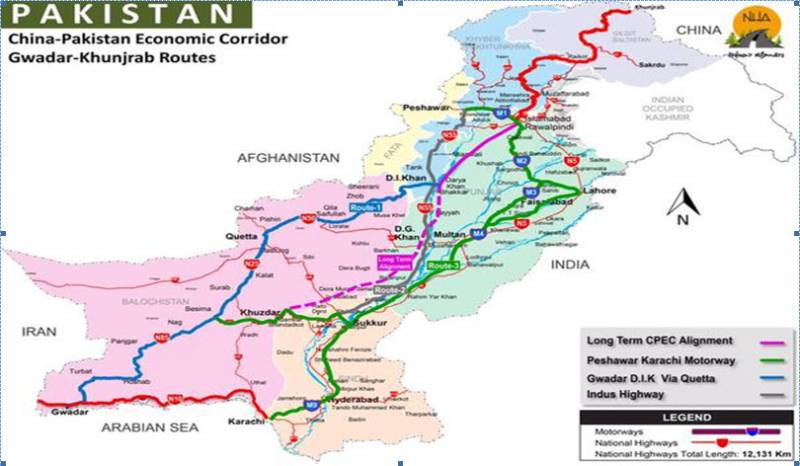Omer Zaheer Meer - The biggest gift of nature to Pakistan besides all kinds of terrains and weather as well as hardworking young manpower is its strategic location. In this context the strategic significance of Gwadar adds to this dimension of Pakistan’s international importance. Gwadar is a strategically located area on the shores of the Arabian Sea just outside the Strait of Hormuz. It is situated near key shipping routes of global oil transportation with the surrounding areas having two-thirds of global oil reserves. Furthermore it is the closest warm-water port to landlocked Central Asian region and Afghanistan, both rich in untapped natural resources and economically undeveloped with huge potential. As if that was not enough, from a military standpoint, Gwadar is located at the eastern bay of the key passing which if blocked by a strong naval force, can cut off the oil supplies to any adversary with dire repercussions as any military expert will testify.
Before moving ahead on the core matter of China Pakistan Economic Corridor (CPEC), let us briefly visit the history of Gwadar. Pakistan identified Gwadar as a site for its future port in 1954 when it was still under the rule of Oman. Government of Pakistan successfully negotiated with the Sultanate of Oman and purchased the enclave in the fall of 1958, ending a 200-year Omani rule of the small undeveloped fishing town. It wasn’t until 1977 that Gwadar was made a part of Balochistan by the Federal Government of Pakistan. Currently it has a population of approximately 85,000 people as per most studies.
Now moving onto CPEC, it is a mega project worth $45.6 billion, to connect Gwadar port with Northwestern China (Xinjiang) via Khunjrab (the last connecting point on the Pakistani side) along with development and uplift of transportation, energy and technical infrastructure in Pakistan. A network of road and rail links besides energy pipelines are envisaged.
There are three land routes planned to link Gwadar to Xinjiang in addition to a long-term “route adjustment link”. The three main routes are outlined below:
1. The “original”, shortest and most popularised route passes through Quetta, Zhob, D.I.Khan and Peshawar. It is termed as the “western route” and is just over 2400 km long.
2. The second route passes through Ratodero, Sukkur and the Indus Highway.
3. The third route which has stirred up the controversy actually passes through Sukkur and Karachi in Sindh and then via Lahore and Peshawar to connect with Khunjrab. This is termed as the “eastern route”.
All the routes are envisioned to be interconnected with industrial and commercial zones along the routes at key sites. Furthermore other major projects that are part of the CPEC are as below:
i. 320-kilometre-long Sukkur-Multan motorway
ii. 120-kilometre-long Thakot to Hawalian road
iii. upgradation of Karakoram Highway
iv. 19-kilometre-long Gwadar port East Bay Expressway Project
v. development of Gwadar itself
vi. building Gwadar airport
vii. upgradation of Karachi–Peshawar “Main (Railway) Line”
viii. commission of armed division (Economic Corridor Support Force) for security of CPEC
ix. Havelian Dry Port
x. Orange Line Metro (Lahore)
xi. Port Qasim 2x660MW Coal-fired Power Plant
xii. 720MW Karot Hydropower Project
xiii. Zonergy 9x100 MW solar project (Quaid e Azam Solar Park) in Punjab
xiv. Jhimpir wind Power project
xv. Thar Block II 2x330MW Coal Fired Power project
xvi. Hubco Coal-fired Power Plant Project
xvii. Gwadar-Nawabshah LNG Terminal and Pipeline Project
xviii. China-Pakistan joint cotton bio-tech laboratory
xix. Cross-border fibre optic data communication system project, a digital terrestrial multimedia broadcast pilot project at Murree
xx. Development of Private Hydro Power Projects, e.t.c.
As can be seen from the above non-exhaustive list, a lot of the projects are related to developing energy and technical infrastructure in Pakistan in addition to the transportation infrastructure projects. In fact more than 70pc of the $45.6 billion is expected to be spent on these projects. However it is the transportation infrastructure that caught most attention due to its long term strategic significance, revenue generation and potential to be the game changer for the region.
Friday, April 19, 2024
Pakistan can’t afford turning CPEC into another Kalabagh Dam

Formula 1 returns to China for Round 5
9:05 PM | April 19, 2024
Germany head coach Julian Nagelsmann extends contract till 2026 World Cup
9:00 PM | April 19, 2024
IMF urges Italy, France to spend less, Germany to loosen purse strings
8:57 PM | April 19, 2024
PM calls UAE president, admires Emirati leadership's response to recent Dubai rains
8:55 PM | April 19, 2024
Church leader calls for including Christians in Gandhara Corridor
8:50 PM | April 19, 2024
A Tense Neighbourhood
April 19, 2024
Dubai Underwater
April 19, 2024
X Debate Continues
April 19, 2024
Hepatitis Challenge
April 18, 2024
IMF Predictions
April 18, 2024
Kite tragedy
April 19, 2024
Discipline dilemma
April 19, 2024
Urgent plea
April 19, 2024
Justice denied
April 18, 2024
AI dilemmas unveiled
April 18, 2024
ePaper - Nawaiwaqt
Advertisement
Nawaiwaqt Group | Copyright © 2024





